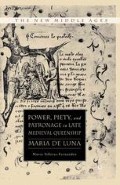Abstract
Like in many contemporary European kingdoms, the queens of the Crown of Aragon administered their own patrimony and managed their own household and court, their consortium domesticum et familiar urn, which was independent of that of the king. The queen’s “house,” which combined private and public spaces and functions, was magnificent, dynamic, and mobile. It was defined not by a concrete location, but by a fluctuating framework of administrators, family members, and servants. Peopled by noblemen, officials, servants, ladies and maidens, clergy and tradesmen, it was at once the practical foundation of queenly power and the venue for formal manifestations of the queen’s agency. Her court and household comprised a base of operations and a protective nucleus for the queen, a cultural center, and a locus of power and patronage. It was a circle into which she admitted choice members of the aristocracy, whom she brought under her protection and control, and who became, in turn, instruments of her influence. The more closely individuals became embroiled in the queen’s household, the greater the benefits that they derived, but the more dependent they became on her continued favor. That said, the queen depended on the loyalty and support of her servants and favorites, and the more that these received the more they would continue to expect.
Access this chapter
We’re sorry, something doesn't seem to be working properly.
Please try refreshing the page. If that doesn't work, please contact support so we can address the problem.
Preview
Unable to display preview. Download preview PDF.
Notes
Ronald G. Asch, “Court and Household from the Fifteenth to the Seventeenth Centuries,” in Princes, Patronage, and the Nobility: The Court at the Beginning of the Modern Age, c. 1450–1650 ed. Ronald G. Asch and A. M. Birke (New York: Oxford University Press, 1991), p. 1–38.
Bonifacio Palacios, “Sobre la redacción y difusión de las Ordenaciones de Pedro IV,” AEM 25–2 (1995): 666; Alvaro Fernández, La corte de Isabel I. Ritos y ceremonias de una reina (1474-1504) (Madrid: Dyckinson, 2002), p. 88.
See, for example, the treatises written for Isabel I of Castile by her confessor, Hernando de Talavera. [Ronald E. Surtz, “Female Patronage of Vernacular Religious Works in Fifteenth-Century Castile: Aristocratic Women and their Confessors,” in The Vernacular Spirit. Essays on Medieval Religious Literature (New York: Palgrave Macmillan, 2002), pp. 264–70.
Antoni Canals, De arra anima (Barcelona: Barcino, 1935), p. 125.
See June Hall McCash, The Cultural Patronage of Medieval Women (Athens: Georgia University Press, 1996), p. 23.
José A. García de Cortázar, “Las necesidades ineludibles: alimentación, vestido, vivienda,” in Historia de España, ed. Menéndez, XIV p. 31; Philip Mantel, Dressed to Rule: Royal and Court Custom from Louis XIV to Elizabeth II (London: Yale University Press, 2005), p. XIV
Henri Bresc, “L’empresa de la correge et la conquete de la Sicile: Le royaume errant de Martin de Montblanc,” AEM 23 (1993), 198
Ana M. Adroer, “Animals exotics alpalaureial de Barcelona,” Medievalia 8 (1988): 13
Asunción Blasco Martínez, “La casa délas fieras de la Aljafería de Zaragoza y los Judíos,” Actas del XV CHCA, 3 vols. (Zaragoza: CSIC, 1993):I:293–318
See Michael Sherman, “Pomp and Circumstances: Pageantry, Politics, and Propaganda in France during the Reign of Louis XII, 1498–1515,” Sixteenth Century Journal 9 (1978): 32.
See Francesc Massip, La monarquía en escena (Madrid: Comunidad de Madrid, 2003), pp. 23–30.
Rafael Narbona, “Las fiestas reales en Valencia entre la Edad Media y la Edad Moderna. Siglos XVI—XVII,” III Congr#x00E8;s d’Hístoría de Catalunya (Barcelona: Universidad, 1993), 443–72
Miguel A. Ladero, Las fiestas en la cultura medieval (Barcelona: Arete, 2004), p. 81
Peter Arnade, Realms of Ritual: Burgundian Ceremony and Civic Life in Late medieval Ghent (Ithaca, NY: Cornell University Press, 1996), p. 128.
Rafael Narbona, “La fiesta cívica: rito del poder real. Valencia, siglos XIV-XVI,” Actas del XV CHCA (Zaragoza: Universidad, 1996), 1(3): 405.
See Jennifer Loach, “The Function of C eremonial in the Reign of Henry VIII,” Past and Present 142 (1994): 45.
For a review of the significance of coronation rituals in history and historiography, see János Bakos, “Coronation Studies—Past, Present, and Future” in Coronations. Medieval and Early Modern Monarchic Ritual (Berkeley: University of California Press, 1990), pp. 1–10.
Jaume Riera Sans, “La coronado de la reina Elionor (1352),” Acta Mediaevalia 26 (2005): 485.
Elizabeth McCartney, “Ceremonies and Privileges of Office:Queenship in Late Medieval France,” in The Power of the Weak, ed. J. Carpenter and S.B. MacLean (Urbana: University of Illinois Press, 1995): pp. 178–219.
Delgado believes the angelic musicians reflected Maria’s appreciation for music, which was common to the Lunas, and appears also in the heraldry of Benedict XIII. Motifs featuring Job, and musicians of which he was considered to be patron, appear frequently in the decoration of the cloister (c. 1376) at the Luna’s monastery of Veruela. See J. Delgado, Job en Venida. Esculturas del claustro gótico del monasterio de Veruela (Zaragoza: Ibercaja, 1996).
See Brigitte Bedos-Rezak “Medieval Identity: A Sign and a Concept,” American Historical Review 105 (2000): 1490–91
Bedos-Rezak, “Women, Seals and Power in Medieval France, 1150–1350,” in Women and Power in the Middle Ages, eds M. Erler and M. Kowaleski (Athens: University of Georgia Press, 1988), pp. 61–82.
F. de Segarra, Sigilografía Catalana, 5 vols. (Barcelona: Henrich, 1915–32).
Copyright information
© 2008 Nuria Silleras-Fernandez
About this chapter
Cite this chapter
Silleras-Fernandez, N. (2008). Court and Ceremony. In: Power, Piety, and Patronage in Late Medieval Queenship. The New Middle Ages. Palgrave Macmillan, New York. https://doi.org/10.1057/9780230612969_7
Download citation
DOI: https://doi.org/10.1057/9780230612969_7
Publisher Name: Palgrave Macmillan, New York
Print ISBN: 978-1-4039-7759-5
Online ISBN: 978-0-230-61296-9
eBook Packages: Palgrave History CollectionHistory (R0)

